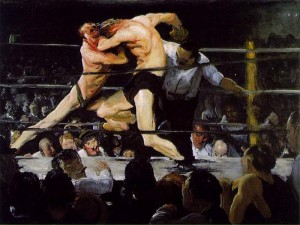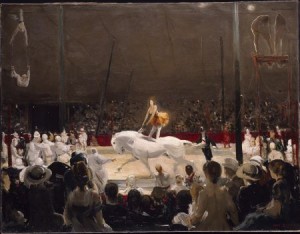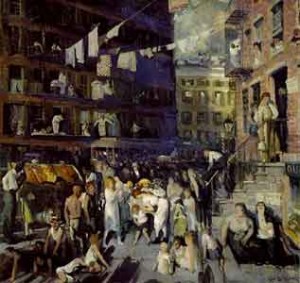The life of George Wesley Bellows(1882-1925) was marked by a substantial body of work encompassing oil paintings, lithographs, sketches and illustrations reflecting bold depictions of Americans and their lives.He is considered to be an icon of early American modernist painting and one of America’s few indisputably great painters. He is also credited with expanding lithographs potential as a fine art medium. Bellows achieved celebrity status by the age of thirty due to dashing brushwork, visual texture, sense of light and representations of movement and direction. His work covered a ”realist” realm that satirized the upper classes and depicted the crudity and chaos of urban New York life.His first medal was from the National Academy of Design in New York in 1908 and he also won the Carnegie Medal from the Carnegie Institute in 1914. He may be one of the greatest realist painters of the first quarter of the 20th century. His period of preeminence was a bridge or hinge between Winslow Homer and Thomas Eakins and the later period of Edward Hopper and Andrew Wyeth.
American art scholar John Wilmerding has stated: ” his (Bellow’s) handling of paint in its luscious, tumultuous, elegant purity would not find reincarnation in American art for another half-century or more.” He is regarded as possessing an outstanding ability to capture the male form in motion and was able to push the male figure to extremes not previously seen. This is evidenced in his famous paintings of amatuer boxing contests. These works are characterized by an exquisite sense of motion and movement.
”As you look at his work, Bellow’s ability to concentrate the eye of the viewer into specific focal points through high contrast of dark and light as well as unexpected and sometimes off setting composition is remarkable.” (C.B. Collins Jr.)
Bellows was initially a student of Robert Henri at the New York School of Art. He became known as one of the Ash Can school of artists Group of Eight and its themes of social realism. Bellow’s career coincided with great technological advances such as motorized vehicles,Einstein’s theories,electricity, ,consumerism and modern warfare. This era saw the first waves of urbanization in America and its creation of ghettos and ethnic enclaves in New York which formed the backdrop of his initial work. Bellows forced a social reflection upon the gentried classes of the potential dangers resulting from of social chaos. There were demands of a more participatory form of social democracy advocated by the Socialists and more ardent factions on the hard left from communists and anarchists such as Theodore Galleani and Theodore Berkman. Over 90% of America’s wealth was controlled by under 10% of its population in the pre-war era. The middle-class was highly marginal.
Bellow’s had a strong anti-war sentiment and was associated with the anarchist movement yet was also pro-conscription and behind America’s involvment in WW1. Bellows understood the dynamics of deterministic class structures and approached his subject in a non-sentimental and decidely anti-romantic manner that was nonetheless nuanced and subtle. In part this social realism was a reaction against the conservative Republican church going midwest milieu from which he was brought up in. Nonetheless, Bellows impact was refreshing and compelling after the academic conservatism of the old pictures at the turn of the century.
Bellows also had a strong anti-clerical streak fearing that the tactics of evengelicals to ”scare folks into the arms of the lord” was contrary to fundamental religious values in addition to inciting racially based hate crime. To Bellows, evangelical firebrand Billy Sunday represented death to the imagination, to spirituality and to art; deeply engaged in a force of authority against beauty. To Sunday, dance was the greatest challenge facing America…”He is such a reactionary that he makes me an anarchist”.(Bellows)
The impact of Goya on Bellows and in particular regarding his depictions of the disaster of war was at that time unprecedented in American art. This is seen in Bellow’s ”The Germans Arrive” which drew parallels to Goya’s ”Third of May”. According to critic C.B. Collins the influence of Goya is evident in Bellow’s style of composition as well as subject matter: …” Like Goya (Bellow’s), his refined portraits are serene
beautiful and his scenes of brutality are full of the same dark energy and drama”.There is no doubt that Bellow’s contempt for authority permitted him to create a technique that was anti-academic and filled with an expressionistic boldness uncommon for that era. It appears his fascination with violence was part of his own inner struggle and conflict memorialized through depictions of class based social satire. Bellow’s paintings are among the most expensive American paintings today. ”Polo Crowd” was sold to Bill Gates for $27.5 million in 1999.
Author Marianne Doezema has asserted that Bellow’s had ”moralistic middle class views” that served to reinforce existing stereotypes among the wealthy leisure classes regarding the urban poor and their congenital character flaws and that these views were ”congenial” to them thus providing a rationale for purchasing Bellow’s work. There is no doubt Bellows was not a revolutionary yet he was allied with the anarchist movement and its extreme advocacy of individual rights. However, he did not provoke or condome acts of violence, though vehemently opposed to the policies of Woodrow Wilson.










 COMMENTS
COMMENTS
Hi. I like the way you write. Will you post some more articles?
Yes,
Usually one per day. I’d glad the writing was able to resonate with you. Please feel free to comment.
Best,Dave